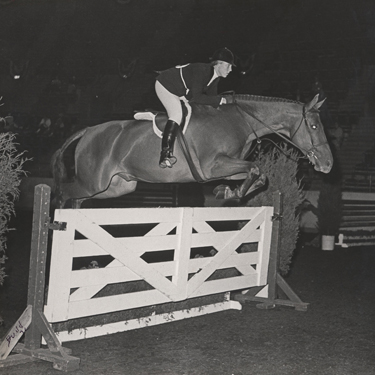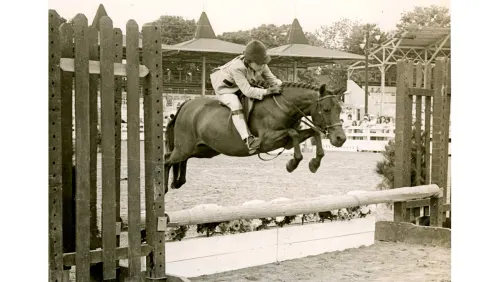Our columnist wants to see tougher courses, bigger fences and more people striving to do—and watch—the hunters at the highest levels.
So many people contacted me about my latest article, “2013: Good News And Bad News For Hunters,” (which ran in the Jan. 27 & Feb. 3 issue of The Chronicle of the Horse, the American Horses In Sport issue), including U.S. Equestrian Federation and U.S. Hunter Jumper Association board members, friends, people I’ve never met and many, many frustrated people. I’ve never had such a positive response to any article I’ve written over the past 12 years for the Chronicle.
People are frustrated, and I’m asking myself what we all can do to improve the hunters and inject some enthusiasm into our sport. The USHJA International Hunter Derby and the brand new Pre-Green Incentive Program have started the ball in a very positive direction, but there’s more to do.
I watched Ben Maher win the $370,000 FEI World Cup qualifier CSI***** at the FTI Winter Equestrian Festival (Fla.) on Jane Clark’s Cella. There were six top riders in the jump-off. It was exciting; it was crowd-pleasing. We witnessed great riding and great horses.
The jumpers seem to be jumping higher, running faster and producing better and better riders and horses. The hunters are wanting to lower the jumps, asking for easier courses, and the numbers are steadily going down in our professional divisions, and for that matter, any division where we jump higher than 3’6″.
We keep manufacturing a division for everyone at any level, and those divisions grow and take away from all the divisions. What can we do? We have top hunter riders, from pony riders through professionals, from all over the country. What goals are we having our riders aspire to?
I’ve been talking to many top professionals from both sides, jumpers and hunters. We rarely have riders now who do both hunters and jumpers, mainly because of the time factor at our shows, which have many rings going at once. Years ago the top riders—Rodney Jenkins, Dave Kelley, Michael Matz—did both divisions. They were horsemen who were great riders in any ring.
ADVERTISEMENT

Old Dominion and Katie Monahan Prudent demonstrated their style over a straight up-and-down gate, once the norm in the hunter ring, at the 1972 National Horse Show, where they earned the conformation hunter championship. Photo by Budd
I love the hunters, but our courses are boring and not a true test of a great horse and a great rider, no matter what level. We have taken the easy route: quick courses because of time restraints. The minute a course designer goes outside the box, the exhibitors go to show management and throw a fit, and it’s back to the same old course: single, side, diagonal.
If you look at pictures from years ago (not that many), we were jumping much more difficult courses, such as outside courses with no related distances. There were pens at the Pennsylvania National, roll tops, straight up-and-down gates, oxer-to-oxer in-and-outs, an oxer for a first jump. Steve Stephens gave us great riding lessons the past two years in the USHJA International Hunter Derby Championships. Those were courses full of technical rider tests, and most of the horses rose to the test.
Maybe it’s time to make the courses more difficult as you go up in height. Maybe the second year green, the high performance and the regular conformation should be more difficult. Maybe those courses should not be the same as the first years and pre-greens. As you climb the ladder and progress, the courses, jumps and distances should get more difficult.
The placement of the handy class in each division has certainly helped, but again the riders are at the mercy of the course designer who makes the handy easy without the true meaning of a handy course. We have time restraints and back-to-back trips using one course for two different types of courses.
It’s hard to train people to ride hunters—it’s an art to ride a hunter well. It should be part of everyone’s riding. The equitation and the hunters were once the foundation of our sport. Many junior horses did both the equitation and the hunters. Now our sport has become so expensive we find our teachers having to direct their students to one of the three divisions: equitation, hunters or jumpers. I’m afraid the hunters are getting the short end of the sport.
I’m not knocking the lower divisions; I’m saying there are too many! I know they are the ones paying the bills for all shows to exist. We are spreading ourselves too thin with all divisions fighting to get horses. They are not steppingstones to higher divisions anymore; they are the end-all for too many riders.
Most of our top jumper riders started in the hunters and equitation; all used steppingstones to become the great riders they are today. I would doubt seriously that any one of our top jumper riders have gone to a course designer and complained that the distances were too difficult or the jumps too big.
ADVERTISEMENT
The derby championships and the top derbies have allowed the great hunter riders of today—Hunt Tosh, Jennifer Alfano, Liza Boyd, Havens Schatt, Peter Pletcher, Scott Stewart and Kelley Farmer—a chance to shine on difficult courses. I doubt any of them went to Steve Stephens and asked him to make it less difficult! Why not ask our up-and-coming professionals to aspire to be better, jump higher and produce great hunters? Let’s make them want the challenges, not the easy way out.
Owners want to participate in derbies because they’re exciting, they pay more money, and they’ve produced better hunter riders. The Pre-Green Incentive is allowing owners to again win money back and pay for a young hunter to participate.
There are many people who are in the governance of our sport who believe we will do better by lowering the jumps. They believe that prize money is not a factor. That thought process is very naïve. The jumpers at all levels are paying good money, and the hunters are at a standstill.
We have no carrot to entice people to ride better and step up the ladder. When we had Madison Square Garden as our year-end show, we had so many hunters fighting to be in that top group to show at this amazing arena. Our indoor shows are struggling and not becoming a year-end goal.
Do I have the answers? I do not, but we need to try to work together to find them. We need the people who are out in the field doing it day after day to help us. Let’s move forward, not backward, to keep our hunters at the top of their game. Hunters are amazing, and they deserve to keep being an important part of our sport.
Susie Schoellkopf, of Buffalo, N.Y., is an active R-rated judge for hunters and equitation. She was a successful hunter rider and now is the owner and manager of SBS Farms, a training stable, as well as the executive director of the Buffalo Therapeutic Riding Center. She’s a member of several U.S. Equestrian Federation committees and a founder of the Horsemen’s Advisory Council. Susie’s first Chronicle column was published in November 2002.















